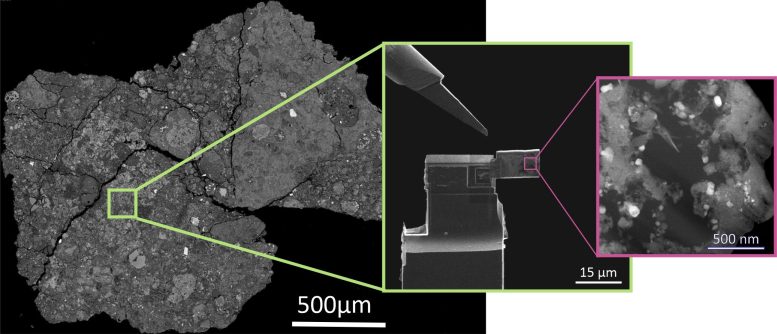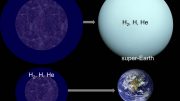
Recent research on the Winchcombe meteorite has uncovered pristine extraterrestrial organic molecules, including amino acids and nucleobases, through advanced electron microscopy analysis. These findings, indicating potential contributions to the development of life on Earth, mark a significant advancement in our understanding of the solar system’s formation and the role of carbonaceous meteorites in delivering organic compounds to the early Earth.
From the vast expanse of interstellar space to the minute realm of atoms: researchers harness advanced microscopes to uncover the chemical and molecular fingerprints of the early solar system inside the recently recovered ‘Winchcombe’ meteorite.
Meteorites represent the building blocks of the solar system, providing key insights into the ingredients from which the planets, including our own, are formed. Research conducted by collaborating institutions, including the University of Leeds, has achieved just that.
A rare group of meteorites, called “carbonaceous meteorites,” are rich in chemical species such as carbon and nitrogen, and likely played a critical role in the delivery of water and organic molecules to the early Earth.
Winchcombe is a carbonaceous meteorite that was widely observed to fall in the UK in February 2021, with the first samples collected only around 12 hours after landing. It thus offers scientists an opportunity to investigate the composition of organic matter in the early solar system without the severe terrestrial alteration effects that usually compromise investigations of meteorites.
Nanoscale Analysis and Discoveries
A multidisciplinary research team including scientists from the Universities of Leeds, Manchester, and York, in collaboration with colleagues at the Natural History Museum in London, Diamond Light Source, the Max Planck Institute for Chemistry in Mainz, and led by the University of Münster in Germany, has provided the first in-depth analysis of organic matter within the Winchcombe meteorite at the nanoscale.
They were able to uniquely correlate synchrotron-radiation data with complementary ultra-high resolution spectroscopic information about the nature of the functional chemical groups present in the organic matter, using one of the most powerful electron microscopes in the world at the SuperSTEM Facility, in Daresbury, Cheshire.

This illustration schematically shows how an extremely thin slice of the meteorite, targeting a region of interest rich in carbon-containing chemicals, can be very precisely extracted for further examination, either under an X-ray beam (at Diamond Light Source), or in the electron microscope (at SuperSTEM). Credit: D.M. Kepaptsoglou, SuperSTEM
This allowed the striking in-situ detection of nitrogen-bearing biorelevant molecules, including amino acids and nucleobases that are fundamental components of the larger, complex proteins used in biology.
The research shows that Winchcombe still contains pristine extraterrestrial organic molecules that, tantalizingly, might have been crucial to the advent of life on early Earth.
The findings have been published in the journal Nature Communications.
Quentin Ramasse, Professor of Advanced Electron Microscopy in Leeds’ School of Chemical and Process Engineering, who led the electron microscopy team at the SuperSTEM Laboratory, said: “This work demonstrates that recent electron microscopy instrumentation advances, including monochromated high-energy resolution electron sources and highly sensitive new detector designs, enable the analysis of extraterrestrial organic matter with unprecedented resolution and efficiency.
“This opens up new avenues of research on these materials in the future using compact, and easily accessible electron microscopy instrumentation in addition to synchrotron radiation.”
Cutting-edge Techniques and Future Implications
Christian Vollmer, Senior Researcher at the University of Münster who led the research, said: “The identification of bio-relevant molecules such as amino acids and nucleobases in Winchcombe without using any chemical extraction methods is hugely exciting, especially as we were able to highlight spatial variations in their local concentration at the nanoscale.
“This suggests that our approach makes it possible to map functional chemistry in meteorites, even though the sizes of the organic domains are extremely small and the abundances of the chemical compounds very low.”
The researchers used the SuperSTEM Laboratory, the UK National Research Facility for Advanced Electron Microscopy, supported by the Engineering and Physical Research Council (EPSRC). The facility houses some of the most advanced facilities in the world for investigating the atomic structure of matter, and is operated with the support of an academic consortium led by the University of Leeds (also including the Universities of Manchester and York, who were involved in this project, as well as Oxford, Glasgow, and Liverpool).
An extremely thin slice of the meteorite, targeting a region of interest rich in carbon-containing chemicals, can be very precisely extracted for further examination, either under an X-ray beam (at Diamond Light Source), or in the electron microscope (at SuperSTEM).
Dr. Ashley King, Research Fellow at the Natural History Museum, where the Winchcombe meteorite is curated, said: “Our observations demonstrate that Winchcombe represents an important addition to the collection of carbonaceous meteorites, with its pristine composition enabling new breakthroughs in our understanding of organic molecules in the early solar system.”
Reference: “High-spatial resolution functional chemistry of nitrogen compounds in the observed UK meteorite fall Winchcombe” by Christian Vollmer, Demie Kepaptsoglou, Jan Leitner, Aleksander B. Mosberg, Khalil El Hajraoui, Ashley J. King, Charlotte L. Bays, Paul F. Schofield, Tohru Araki and Quentin M. Ramasse, 26 January 2024, Nature Communications.
DOI: 10.1038/s41467-024-45064-x
The electron microscopy facilities were funded by the Engineering and Physical Science Research Council.









Isn’t Earth itself is bigger meteorite than associating biological molecule with these tiny ones? And didn’t they fall on all other solar planets? If all these solar bodies could communicate with us, they would tell us that this planet is in the phase appropriate for bio system support and evaluation, apart from conditions and phases elsewherein the solar system.
A meteorite is defined as a debris that has survived transport through the atmosphere. Earth is usually seen as a result of protoplanet mergers and other accretion (including late meteorites).
The biological method of phylogeny (ancestry) relationships placed biology as splitting from geology here on Earth in 2016, and this year the first dating method that pulled up the root dating by cross-correlation dated life evolution to ~ 4.42 +/- 0.1 billion years. [Naive dating methods push the root back towards the Moon forming impact sterilization, this is the first time a reliable method was used.] It is likely life evolved locally and diversified prodigiously by geological organics.
Though of course organics inflow of nutrients from space helped then, and this research expanding on the potential library of such compounds helps geobiologists now.
Sometimes I sit and look at my hand and think how am I’m here,yea I know all about cells, genes, electrons, quarks, protons ect, and I’m certainly not religious,so that poses the question, I belive there is life out in space, but I do not belive aliens have ever been here because of the distances,so now I’m back to square one, no one has properly explained it, sitting here looking at my hand and wondering…???
Keith, you exist and were created by an amazing designer. There is no way all the intricate details of you being are the result of chance. Like every designer, the designer I speak of had specific purposes for making you; right down to the unique fingerprint at the tip of your pinky.
You join the billions of humanity with similar basic attributes and all near the image of their Creator – God.
With him you must begin. Search for him as you would the answer that deny him. He is a rewarder of those who diligently seek him. In the Bible, please consider the book of Hebrews, chapter 11. Notice verse 6 which states, ” and without faith, it is impossible to please him, for whoever would draw near to God must believe that he exists and that he rewards those who seek him.”
Let your amazement grow into a hunger for the glory and grace of your Creator. With this I also pray that you will soon see the intimacy of the Savior and call out for faith. He will not refuse you.
In Christ,
Kurt
Still wondering…??